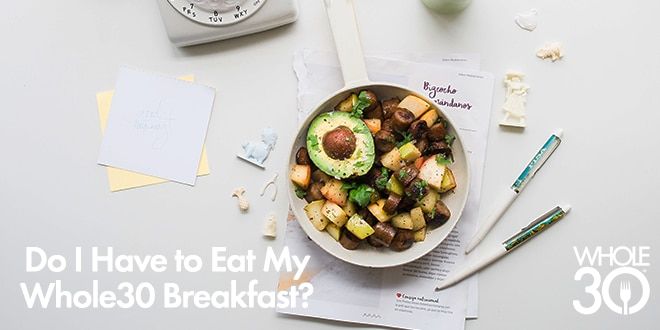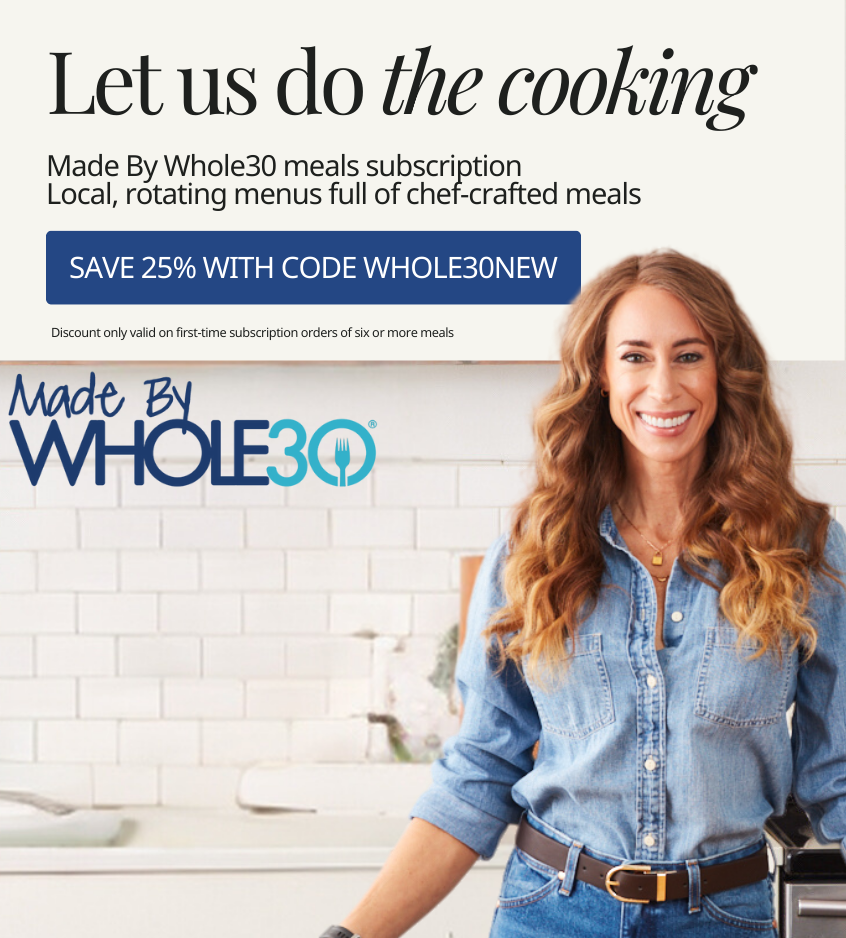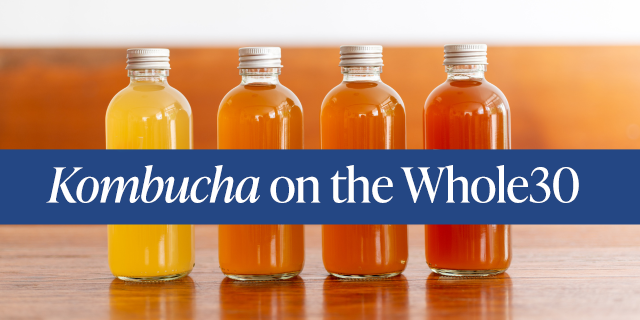By Shanna Keller, who enthusiastically eats an egg-free Whole30 breakfast hash almost every morning
“Ever since I was a child I haven’t been a breakfast eater. I’m on Day 8 and couldn’t force myself to eat another breakfast today. I’ve gagged one down every day except today. Any pointers?” – @shanell785
When I was preparing for my first Whole30, there were two challenges that seemed nearly insurmountable. The first was not having half-and-half in my morning coffee.* The second was eating breakfast. Every day. Following the Whole30 meal template, which meant I would ideally include a protein, veggies, and a healthy fat on my breakfast plate. The idea was so overwhelming that I nearly scrapped my Whole30 plans entirely.
For the first three weeks of my Whole30, I struggled at breakfast time. I was nauseated, overwhelmed, and frustrated. I got out of my warm, cozy bed early to what… stand in this dark kitchen and choke down an egg? No. Just… no. Is it melodramatic to admit that most mornings I was on the verge of tears? Because I was. I hated breakfast so much, it literally made me cry.
*My first Whole30 was in the fall of 2013. Back then, nut-milk based coffee creamers were practically non-existent, hence the famous “Drinking coffee black is not hard” line in The Whole30. Now, I prefer Whole30 Approved nutpods to half-and-half.
Your Mom Was Right
The Whole30 was asking me to reverse a deeply-ingrained habit that started when I was in high school. I woke up sick to my stomach, grouchy and foggy every day, with no appetite for anything but coffee with cream. I didn’t eat anything until about noon or 1pm, when I’d become suddenly ravenous for lunch.
Judging by conversations I’ve had with fellow breakfast resisters, this is a pretty common experience. Most likely, the cause is hormonal. Here’s what The Whole30 has to say about skipping breakfast—for which there really is a “most important meal of the day” case to be made:
If you’re not hungry in the morning, it’s a good indicator that hormones like leptin and/or cortisol aren’t rising and falling when they should be. One of the best ways to get those hormones back in line is to eat something in the morning, when it’s biologically appropriate. If you start eating too late in the day, your entire hormonal rhythm and daily eating patterns can be thrown off–so come nighttime, you’ll tend to crave more food. Usually not the good kind, either. Which means that you’ll be prowling through your pantry or freezer after dinner looking for a snack, leading to more hormonal disruption. In summary, ideally you’ll eat breakfast within an hour of waking to keep your metabolism on track.*
If you’re really not hungry first thing in the morning, here’s our rule of thumb: no coffee before breakfast. We know, you hate that idea, but coffee is an appetite suppressant, which will make it even harder for you to eat. So fire up the frying pan before the percolator–it’s for your own good.
So, yes, we want you eating breakfast during your Whole30. Here are three ways to make it a little easier.
*If you do high-intensity or endurance activity very early in the morning, you can follow the detailed recommendations in It Starts With Food (or the simple ones in our meal template) to have a small morning snack before you train, then a post-workout meal immediately following your session, followed by a normal breakfast an hour or two later. If you want to make your PWO meal your breakfast, that’s cool… just make sure you get an extra meal or a snack in later in the day, as with your activity levels, you probably need extra calories/carbohydrates. See the For Athletes section of the Whole30 Forum for more guidance.
Three Whole30 Breakfast Strategies
Mini-meals Going from absolutely zero food at breakfast to a full meal following the Whole30 meal template is a big ask. Instead, compose mini-meals that follow the spirit of the meal template, but with smaller portions.
A 3-egg omelette stuffed with spinach, mushrooms, red peppers, and avocado might feel impossible at 7AM, but maybe you can do one hard-boiled egg, a few roasted veggies, and a slice of avocado. (If you do this, you’ll need to either add a fourth meal to make up protein and calories, or make your other two meals pretty big. We don’t want you under-eating.)
Start small, and see if you can gradually increase the size of your breakfasts until you’re eating full sized meals by Day 30. Starting your day with a mini-breakfast may also wake your appetite up enough that an hour later, you’re ready for a full Meal 1—in which case, consider that the first real meal of the day.
Bone broth soups During my first Whole30, bone-broth based soups were the only meal that was palatable and light on my stomach. I’d put 1 or 2 cups of bone broth in a small sauce pan, bring it to a simmer, and poach a handful of fresh veggies (my favorites were zucchini and mushroom). Then I’d add some pre-cooked shredded chicken or ground beef, simmering it all together until warmed through. If I was feeling really brave on a particular morning, I’d toss in some fresh arugula or spinach at the end.
Ideally, your breakfast needs to contain some protein—it’s satiating, will be less disruptive to blood sugar than a fruit smoothie, won’t leave you starving an hour later, and studies show it’s one of the keys to healthy, sustainable weight loss… if that kind of thing interests you. But protein doesn’t have to mean eggs! Any protein will do, so add chicken, turkey, beef, salmon, sausage, or any meat that suits your fancy and your appetite. (Lighter meats work better in this context—but don’t rule out a burger for breakfast once your appetite catches up with your new, healthy habits!)
Prepped Meals It wasn’t just eating food in the mornings that grossed me out… it was food in general. Everything about it. Looking at it. Touching it. Cooking it. Please. I couldn’t muster the willpower to cook a breakfast hash, but I could pull a prepared hash out of the fridge and warm it in the microwave. Do your morning self a favor, and stock your freezer and refrigerator with prepped breakfast options so that you have no excuse for not at least trying to eat something for breakfast.
Pre-Made Paleo is a great option here. Their portions are moderate; perfect for a light breakfast for one. And you can find some of your Whole30 favorites, like Melissa’s Chicken Hash, on their menu. You can also prep meals ahead of time, using techniques in our 5-part Whole30 Freezer series, pulling them out as you need them throughout the week. (The No-Fuss Salmon Cakes from The Whole30 book work really well here.)
Flip the Switch
Around week four of my first Whole30, something switched. I started waking up hungry and eating food first thing in the morning was suddenly the most glorious idea in the world. I became a breakfast gal, and eating a Whole30-compatible breakfast is now one of my most important Food Freedom Forever habits. With a nourishing breakfast in me, I wake up and shake off that morning fogginess quicker; I think clearer; I am more creative and a better problem solver at work, and I’m more likely to view myself as a person who prioritizes healthy habits no matter what my schedule throws at me.
So hang in there, breakfast-hater. I empathize with your struggle, but I know it’s worth fighting through to the other side.
Looking for some delicious no-egg breakfast ideas? We’ve got THREE inspirational articles from the @Whole30Recipes Instagram feed right here on our blog.
















